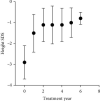A Retrospective Analysis of Patients with Short Stature in Eastern China between 2013 and 2019
- PMID: 33997034
- PMCID: PMC8081605
- DOI: 10.1155/2021/6640026
A Retrospective Analysis of Patients with Short Stature in Eastern China between 2013 and 2019
Abstract
Objective: To identify the aetiology of growth and development diseases and assess the long-term effectiveness of recombinant human growth hormone (rhGH) therapy in a real-life clinical setting and provide better guidance in clinical strategy and decision making.
Methods: This retrospective study included 1145 children and adolescents with short stature admitted to the Department of Endocrinology, Affiliated Hospital of Jining Medical University, from January 2013 to December 2019, of whom 484 received rhGH treatment. The related anthropometrics and laboratory examinations were assessed in all participants.
Results: A total of 1145 children and adolescents with short stature aged 10.5 ± 3.3 years, including 740 boys and 405 girls, were analysed in this study. The number of children and adolescents with short stature gradually increased per year from 2013 to 2019. The mean pretreatment height standard deviation score (SDS) and insulin-like growth factor-1 SDS were -2.93 ± 1.05 and -1.01 (-1.83--0.16), respectively. The majority of the children (658, 57.47%) were prepubescent. In total, 484 subjects aged 10.6 ± 3.2 years received rhGH and were followed up, and among them, 292 children were treated for more than one year. As the treatment time increased, the children's height SDS gradually increased, and most of them attained a height SDS within the normal range. The mean height SDS in children who were treated for more than one year was -3.0 ± 1.0 at baseline and gradually increased to -0.8 ± 0.3 by year 6. The results were consistent across subgroups of different aetiologies of short stature.
Conclusions: Increasing attention has been given to the height of children during the period of 2013-2019 in eastern China. The present findings indicate that children with short stature need to be referred to a specialist centre to diagnose the cause of growth failure and that short children receiving rhGH therapy show a significant increase in height over time.
Copyright © 2021 Qianqian Zhao et al.
Conflict of interest statement
The authors declare that they have no competing interests.
Figures
Similar articles
-
Effect of long-acting PEGylated growth hormone for catch-up growth in children with idiopathic short stature: a 2-year real-world retrospective cohort study.Eur J Pediatr. 2024 Oct;183(10):4531-4539. doi: 10.1007/s00431-024-05719-9. Epub 2024 Aug 19. Eur J Pediatr. 2024. PMID: 39158594 Free PMC article.
-
Short stature and growth hormone use in pediatric hemodialysis patients.Pediatr Nephrol. 2005 Dec;20(12):1794-800. doi: 10.1007/s00467-005-1893-x. Epub 2005 Aug 18. Pediatr Nephrol. 2005. PMID: 16133065
-
Combined therapy with GnRH analogue and growth hormone increases adult height in children with short stature and normal pubertal onset.Endocrine. 2020 Sep;69(3):615-624. doi: 10.1007/s12020-020-02375-5. Epub 2020 Jun 12. Endocrine. 2020. PMID: 32533506
-
Clinical Characteristics and Long-Term Recombinant Human Growth Hormone Treatment of 18q- Syndrome: A Case Report and Literature Review.Front Endocrinol (Lausanne). 2021 Dec 9;12:776835. doi: 10.3389/fendo.2021.776835. eCollection 2021. Front Endocrinol (Lausanne). 2021. PMID: 34956087 Free PMC article. Review.
-
Growth and Clinical Characteristics of Children with Floating-Harbor Syndrome: Analysis of Current Original Data and a Review of the Literature.Horm Res Paediatr. 2019;92(2):115-123. doi: 10.1159/000503782. Epub 2019 Nov 12. Horm Res Paediatr. 2019. PMID: 31715605 Review.
Cited by
-
Height outcomes in Korean children with idiopathic short stature receiving growth hormone treatment.Front Endocrinol (Lausanne). 2022 Sep 7;13:925102. doi: 10.3389/fendo.2022.925102. eCollection 2022. Front Endocrinol (Lausanne). 2022. PMID: 36157444 Free PMC article.
-
CTCF variant begets to short stature by down-regulation of IGF1.J Mol Endocrinol. 2023 Apr 5;70(4):e220193. doi: 10.1530/JME-22-0193. Print 2023 May 1. J Mol Endocrinol. 2023. PMID: 36847142 Free PMC article.
-
Long-Term Efficacy and Safety of Growth Hormone in Children Suffering from Short Stature in China (CGLS): An Open-Label, Multicenter, Prospective and Retrospective, Observational Study.Adv Ther. 2025 Jun;42(6):2957-2969. doi: 10.1007/s12325-025-03146-2. Epub 2025 Apr 8. Adv Ther. 2025. PMID: 40198521 Free PMC article.
-
Non-linear relationship between sleep duration and blood pressure in children with short stature.Front Pediatr. 2023 Nov 6;11:1302750. doi: 10.3389/fped.2023.1302750. eCollection 2023. Front Pediatr. 2023. PMID: 38027291 Free PMC article.
-
Association Between the Growth Hormone/Insulin-Like Growth Factor-1 Axis and Muscle Density in Children and Adolescents of Short Stature.Front Endocrinol (Lausanne). 2022 Jun 14;13:920200. doi: 10.3389/fendo.2022.920200. eCollection 2022. Front Endocrinol (Lausanne). 2022. PMID: 35774144 Free PMC article.
References
MeSH terms
Substances
LinkOut - more resources
Full Text Sources
Other Literature Sources
Medical
Research Materials



